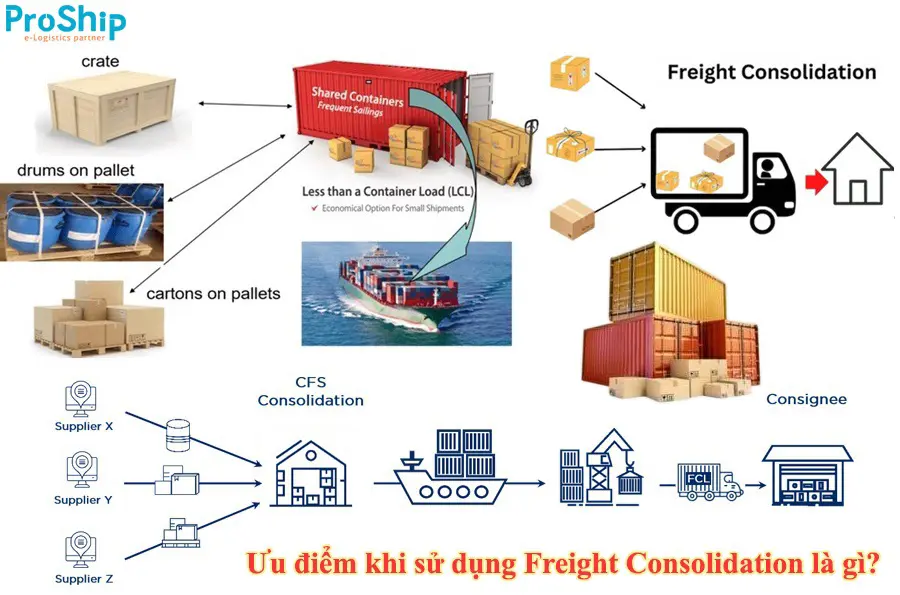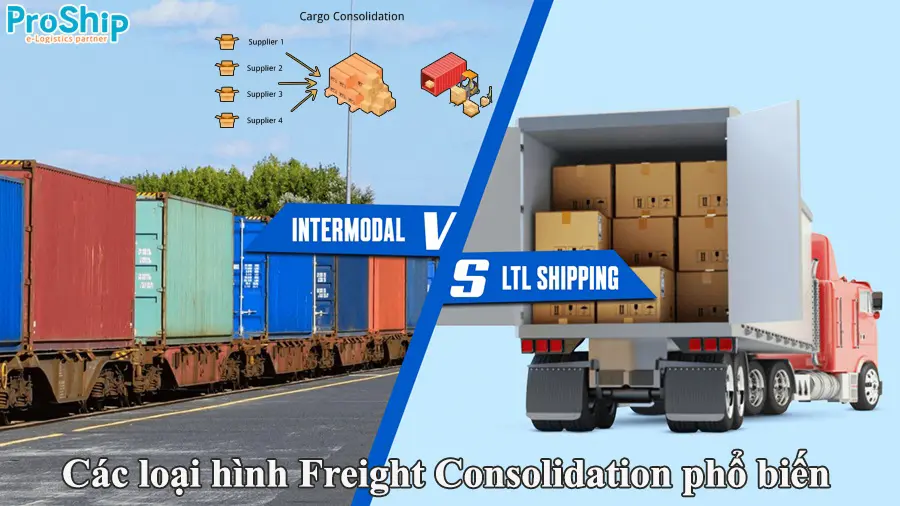x Businesses, goods owners, online business shops, ... need to find out details about Freight Consolidation?
X You want to know how Freight Consolidation plays? When to use this delivery method?
x You wonder the types and advantages of Freight Consolidation? What is the process of conducting Freight Consolidation?
Proship.vn we will answer what Freight Consolidation method is; The role, benefits and advantages of Freight Consolidation; The popular types of freight consolidation, ... Along with that is the process of consolidation consolidation that the shippers and import -export enterprises need to know.
What is Freight Consolidation?
What is Freight Consolidation? Freight Consolidation is also known as LCL (Less Than Container Load) is the process of combining small shipments into large shipments to reduce the number of containers or pallets necessary for transportation. Thereby helping to optimize container capacity or transport vehicles and minimize shipping costs for businesses.

So, when to use consolidation? If you have a small number of goods you want to send and do not want to pay high costs to rent all containers or cargo compartments, you should choose Freight Consolidation. Logistics will combine many people and packed in containers or cargo compartments to save costs for the parties.
Good price container shipping service
Why do individuals/businesses collect goods?
What is the reason for businesses/individuals to collect freight consolidation goods? Because of the fact, gathering goods benefits for senders (exporters), forwarders, and units performing the transportation tasks. Specifically:
Consolidation benefits with the delivery unit
For delivery units when carrying out the consolidation operation, the difference fee will be enjoyed by the individual shipper with actual charges paid to the carrier.
Consolidation benefits with export units
The benefits of consolidation activities are to help senders to enjoy lower rates than actual rates payable to the transport unit (the more the cost is saving when the amount of goods is larger).
In addition, with the strong development of the logistics market, exporters easily find a partner that can provide themselves to collect goods for themselves, use many goods routes, Door To Door services and convenient delivery.
Consolidation benefits with transportation units
Through delivery units, shipping units when collecting goods will save a lot of time, the cost of handling papers because they do not have to open declarations, perform detailed operations for each retail shipment.
Evaluate the advantages when using Freight Consolidation
What is the advantage of Freight Consolidation? That is:
Save transportation costs
Freight Consolidation helps businesses save shipping costs by combining many shipments from many different sources on a single shipping. Customers do not need to use many vehicles and perform many shipping, the combination of goods on one trip will minimize shipping costs, labor costs and goods insurance costs.
Optimize storage space
Freight Consolidation helps optimize storage space during freight. Instead of storing each individual shipment, businesses can combine the shipment and shipping at the same time. The optimization of storage space helps save costs, increase performance and flexibility in goods management.
Minimize risks in transportation
Freight Consolidation combines many shipments on the same shipping, so the management and supervision of goods will be easier. At the same time, the use of multimedia transportation also helps minimize the risk of loss, damage or malfunction during transportation.
Reduce the time and effort of transportation
With Freight Consolidation service, you will not have to handle each individual shipment, the shipments can be combined and shipped together, thereby helping to reduce time and effort to process and transport goods. Transport staff also focused on other activities such as checking and ensuring the quality of goods, thereby increasing efficiency and meeting the maximum customer needs.

Use a variety of means of transportation
Freight Consolidation provides flexibility when using a variety of vehicles including trucks, containers, ships, aircraft and railways. The use of these diverse means of transport helps quickly meet the transport needs of customers and optimize the shipping process.
Optimize the use of all kinds of transportation
Multimedia service in Freight Consolidation helps optimize the use of transportation. Through the classification of goods and selecting appropriate means of transportation, this service helps reduce risks in transportation and increase transport efficiency.
Ensure flexibility and quick response
Freight Consolidation always ensures flexibility and quick response to customer needs. Effective processes and communication systems apply to ensure information and transport requirements are conveyed and processed quickly and accurately.
READ MORE: Get refrigerated Container shipping at good prices
Types and processes and processes of freight consolidation
Let's explore the types of types and processes of freight consolidation:
Freight consolidation types
Common types of freight consolidation include:
Full truckload (FTL)
Full Truckload (FTL) is used when the goods of the business are large enough to fill a truck. In FTL, a truck is used to transport goods of a single company. This helps ensure safety and security for goods, and minimize risks and waiting time.
Less Than Truckload (LTL)
Less Than Truckload (LTL) is used when the goods of the business are not large enough to fill a truck. Instead of transporting individual goods, LTL allows businesses to share space on the same truck with other companies. This helps reduce transportation costs and increases the ability to use maximum space on trucks.
Intermodal Freight
Intermodal Freight uses many vehicles such as ships, trucks and railways. This allows the goods to be transported from the starting point to the destination through many vehicles. Intermodal Freight helps optimize transportation process, minimizing shipping time and cost.

Freight consolidation process
The process of collecting goods is conducted as follows:
- Step 1: Collect goods receiving retail shipments from many different ships at the delivery and packaging station (CFS);
- Step 2: Collect goods gathered into raw shipments, customs inspections and close to CFS tai containers;
- Step 3: Collect goods send these containers by sea to agents at the destination;
- Step 4: Agents of the cargoer in the destination to receive these containers, unload the goods in and deliver to the CFS recipient of the destination.
What is Freight Consolidation and the knowledge related to the method of collecting retail goods of LCL including benefits, outstanding advantages, cargo processes, ... have been answered in the most detailed and complete way. Proship Logistics we are one of the units of FCL and retail goods LCL, transporting multimodal goods cheap, contact 0909 344 247 for advice on safe, efficient and cost -effective delivery solutions.
